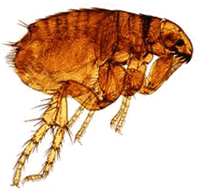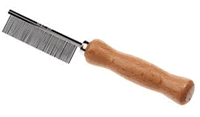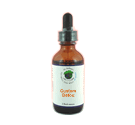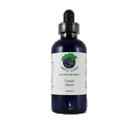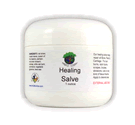|
|
Flea Toxin Detox Information
Fleas are wingless insects with mouthparts that look like tubes and are adept at piercing skin and sucking blood. They are usually dark in color with long legs, the hind pair well adapted for jumping. A flea can jump vertically up to 7 inches (18 cm) and horizontally up to 13 inches (33 cm). This is nearly 200 times their own body length, making the flea one of the best jumpers of all known species. The flea body is hard, polished, and covered with lots of hairs and short spines directed backward, which also assist its movements on the host. Their tough body is able to withstand great pressure. Even a hard squeezing between the fingers is normally insufficient to kill a flea.
Some people and animals suffer allergic reactions to flea saliva resulting in rashes. Flea bites generally result in the formation of a slightly raised, swollen itchy spot with a single puncture point at the center (similar to a mosquito bite, see photo below). The bites often appear in clusters or lines of two bites and can remain itchy and inflamed for up to several weeks.
Pulicosis is a skin condition caused by several species of fleas. These include: the cat flea, dog flea, human flea, moorhen flea and rat flea. The condition can manifest after only one flea bite and may not even be noticed. Within minutes skin irritation begins. This can range from extremely mild to severe. After 48-72 hours, a more severe form may begin to spread throughout the body. Symptoms include: swelling of the bitten area, redness, ulcers of the mouth and throat, irritation and tenderness of the areolas. Within one week the condition may spread through the lymph nodes and begin affecting the central nervous system, which is a serious condition! Permanent nerve damage can occur.
Besides the problems posed by the creature itself, fleas can also carry several diseases. Fleas transmit a variety of viral, bacterial and rickettsial diseases to humans and other animals. They also deliver protozoans and helminthes (worms). Fleas have assisted in the spread of epidemics, such as transmitting Yersinia pestis bacteria rodents and humans which caused the bubonic plague. Fleas can transmit Yersinia pestis, Rickettsia typhi, Rickettsia felis, Bartonella henselae, Trypanosome protozoans and Hymenolepiasis tapeworm.
The total life span of a flea can be as short as two weeks, but may be several months in ideal conditions. Female fleas can lay 500 or more eggs in their lifetime, allowing for phenomenal growth rates. If you suspect fleas, the first thing you need to do is look for flea feces. This will be small grains of what appears to be dirt. If you take this 'dirt' and rub it between your fingers with a small amount of water and it turns red you've found your proof. This is because flea feces contains dried blood. Get a flea comb and use it as directed on each family member and pet, then proceed to clean the home.
More than three quarters of a flea's life is spent somewhere other than on the host animal so it is not adequate to treat only the host; it is important to also treat the host's environment. Combating a flea infestation in the home requires patience because for every flea found, there could be many more developing in the home. Humidity is critical to flea survival. Eggs need relative humidity of at least 70–75% to hatch and larvae need at least 50% humidity to survive. In humid areas, about 20% of the eggs survive to adulthood; in arid areas, less than 5% complete the cycle. Fleas thrive at higher temperatures, but need 70° to 90°F (21° to 32°C) to survive. Lower temperatures slow down or completely interrupt the flea life-cycle. Borax dehydrates the fleas so sprinkle it on the carpet and run a broom over it. Then let it sit for an hour and vacuum thoroughly. A laboratory study done at the University of California showed that vacuuming catches about 96% of adult fleas. Make sure the vacuum bag is eliminated from your home. A combination of controlled humidity, temperature, and vacuuming should eliminate fleas from an environment. Altering even one of these environmental factors may be enough to drastically lower and eliminate an infestation. Red Cedar Oil. Often used by the military as a safe, effective remedy for bed bugs, you can find this online and use as directed.
Our Flea Detox Remedy is not for the removal of fleas, but for detoxing the many issues that are caused by flea bites. The remedy detoxifies flea saliva, poisons and the many toxins people put on flea bites including: lufenuron, imidacloprid, permethrin, and (S)-methoprene, acetylcholinesterase, antihistamines or hydrocortisone and Calamine lotion.
Remember that our Liquid Detox is one of the most effective remedies for treating/healing bites and wounds. It is powerful at helping reduce pain, swelling and itching, and is very effective at preventing infection. You can apply it directly to the bite or wound or soak the absorbent part of a band aid (3-5 drops) in Liquid Detox and apply it to the bite or wound.
|
|
|
 Arthropod/Vector
Bacteria
Chemicals
Fungus /Mold
/ Yeast Metals Parasites Virus Other
Arthropod/Vector
Bacteria
Chemicals
Fungus /Mold
/ Yeast Metals Parasites Virus Other
